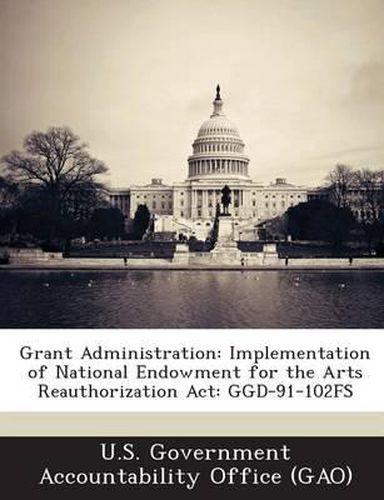Readings Newsletter
Become a Readings Member to make your shopping experience even easier.
Sign in or sign up for free!
You’re not far away from qualifying for FREE standard shipping within Australia
You’ve qualified for FREE standard shipping within Australia
The cart is loading…






Pursuant to a legislative requirement, GAO studied the National Endowment for the Arts’ (NEA) operating practices and procedures, focusing on such NEA practices as: (1) the membership of review panels; (2) limitations on the number of terms review panel members may serve; (3) conflict of interest requirements; (4) grant application reporting requirements; and (5) the institution of interim reporting and installment grant payment procedures. GAO found that: (1) NEA panel members are appointed to 1-year terms and may not serve more than 3 consecutive years; (2) each panel is composed of experts in the program being reviewed, including artists, art administrators, representatives of state and local art agencies, and knowledgeable lay people; (3) policy NEA panels provide input on program guidelines, funding, practices, and priorities, while grant advisory panels make the initial recommendation to the National Council on the Arts for approval or rejection of a grant application; (4) NEA does not routinely maintain summary information on the reasons why applications are returned or rejected, but each office maintains files on each application that include this information; (5) NEA now requires all panels to be free of conflicts of interest; (6) all applicants must provide a project description and certain grantees must provide interim reports; (7) for 50 of the 141 program categories no more than two-thirds of the grant can be paid when the application is approved and the remaining one-third cannot be paid until the NEA chairman determines that the grantee is complying with the conditions of the grant; and (8) a panel’s consideration of a grant application progresses from the introduction through a presentation of material, discussion of the application, recording of initial panel recommendations, determination of recommended grant and funding amounts, and final review and adjustment of recommendations.
$9.00 standard shipping within Australia
FREE standard shipping within Australia for orders over $100.00
Express & International shipping calculated at checkout
Pursuant to a legislative requirement, GAO studied the National Endowment for the Arts’ (NEA) operating practices and procedures, focusing on such NEA practices as: (1) the membership of review panels; (2) limitations on the number of terms review panel members may serve; (3) conflict of interest requirements; (4) grant application reporting requirements; and (5) the institution of interim reporting and installment grant payment procedures. GAO found that: (1) NEA panel members are appointed to 1-year terms and may not serve more than 3 consecutive years; (2) each panel is composed of experts in the program being reviewed, including artists, art administrators, representatives of state and local art agencies, and knowledgeable lay people; (3) policy NEA panels provide input on program guidelines, funding, practices, and priorities, while grant advisory panels make the initial recommendation to the National Council on the Arts for approval or rejection of a grant application; (4) NEA does not routinely maintain summary information on the reasons why applications are returned or rejected, but each office maintains files on each application that include this information; (5) NEA now requires all panels to be free of conflicts of interest; (6) all applicants must provide a project description and certain grantees must provide interim reports; (7) for 50 of the 141 program categories no more than two-thirds of the grant can be paid when the application is approved and the remaining one-third cannot be paid until the NEA chairman determines that the grantee is complying with the conditions of the grant; and (8) a panel’s consideration of a grant application progresses from the introduction through a presentation of material, discussion of the application, recording of initial panel recommendations, determination of recommended grant and funding amounts, and final review and adjustment of recommendations.